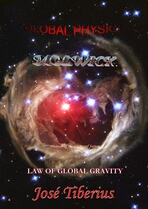3.b.2. Gravitational potential energy
The gravitational potential energy of a mass m at a given point in space is the work done by the gravitational field to transfer mass m from such point to infinity. According to this definition, potential energy is always negative, and its maximum is always zero. To be negative does not help much brain reasoning.
There must be reasons to resort to this kind of formalization of gravitational potential energy. We guess the maximum value, the minimum or something like that is unknown; in any case, we should accept that it should always be positive.
The different types of energy and their relationships give us keys about gravity nature.
Sections of Newton’s Law of Universal Gravitation and Global Law of Gravity explained both components of the atractis causa.
If what one is searching for is a more conventional approach to potential energy definition, Wikipedia’s page is always right.
When something is unknown for sure, temporary solutions are correct to move forward. The existence of negative energies, even being a convention, is an excellent example of what not to do, as it leads to a conflict with primary brain references when structuring new concepts.
Mechanical energy is the sum of kinetic energy and gravitational potential energy of bodies with mass in a gravity field.
Here lays a terminological problem since it is taught firstly that Ep = mgh, and later that Ep = - GM m/r which are nearly equivalent expressions for the calculus of energy variations with height; however, the origin of energies alters and, therefore, concept alters and the hereinabove mentioned negative sign appears. We should point out that energy is a scalar magnitude.
Thus, it is easy to come to understand the difficulty of comprehending any theory about gravity.
Montparnasse tower

Regardless, with or without negative magnitudes, due to changes in properties of the bodies with variations in gravity field intensity and, in Global Physics, also with relative speed to the Global Aether (gravitational - kinetic - mass), gravitational energy is a complex manifestation of elastic energy.
As commented on the page about mechanical energy, this one continues to be a valid concept as the sum of kinetic energy and gravitational potential energy, but with the following observations:
The mass increment due to speed, already pointed out by General Relativity and the corresponding increase in gravity force causes a bigger a more significant increase in kinetic energy than in Newton’s Classical Physics.
Increase in gravity force due to speed, independently of the increase mentioned in the previous point, explained by the second component of the atractis causa or Merlin effect, causes an additional increase in the kinetic energy and, therefore, in the gravitational potential energy.
General Relativity also carries out this adjustment; however, instead of modifying gravitational potential energy, it stretches and expands space-time for each particular mass.
The section about movement with gravity of the book Physics and Global Dynamics studies the reticular mechanism of kinetic energy causing motion on bodies with mass in the gravitational, kinetic or Global Aether, with the typical radial symmetry of gravitational potential energy.
